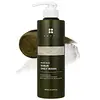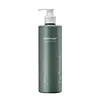What's inside
What's inside
 Key Ingredients
Key Ingredients

 Benefits
Benefits

 Concerns
Concerns

 Ingredients Side-by-side
Ingredients Side-by-side

Water
Skin ConditioningPotassium Cocoyl Glycinate
Glycerin
HumectantMicrocrystalline Cellulose
AbsorbentSea Silt
Skin ConditioningPotassium Cocoate
EmulsifyingLauryl Hydroxysultaine
CleansingAcrylates/Beheneth-25 Methacrylate Copolymer
Sodium Chloride
MaskingPropanediol
SolventSalicylic Acid
Masking1,2-Hexanediol
Skin ConditioningCaprylyl Glycol
EmollientEthylhexylglycerin
Skin ConditioningEucalyptus Globulus Leaf Oil
PerfumingMannan
Disodium EDTA
Dipotassium Glycyrrhizate
HumectantButylene Glycol
HumectantSalix Nigra Bark Extract
Skin ProtectingBetula Platyphylla Japonica Juice
Skin ConditioningCodium Tomentosum Extract
Skin ProtectingEcklonia Cava Extract
Skin ConditioningGelidium Cartilagineum Extract
Skin ProtectingHizikia Fusiforme Extract
Skin ConditioningCitrus Unshiu Peel Extract
MaskingCamellia Japonica Flower Extract
EmollientOenothera Biennis Flower Extract
AstringentRubus Fruticosus Fruit Extract
AstringentSambucus Nigra Fruit Extract
AstringentVaccinium Macrocarpon Fruit Extract
AstringentChamaecyparis Obtusa Leaf Extract
Skin ConditioningAdansonia Digitata Seed Extract
Skin ConditioningBambusa Arundinacea Stem Extract
Skin ConditioningCeramide NP
Skin ConditioningWater, Potassium Cocoyl Glycinate, Glycerin, Microcrystalline Cellulose, Sea Silt, Potassium Cocoate, Lauryl Hydroxysultaine, Acrylates/Beheneth-25 Methacrylate Copolymer, Sodium Chloride, Propanediol, Salicylic Acid, 1,2-Hexanediol, Caprylyl Glycol, Ethylhexylglycerin, Eucalyptus Globulus Leaf Oil, Mannan, Disodium EDTA, Dipotassium Glycyrrhizate, Butylene Glycol, Salix Nigra Bark Extract, Betula Platyphylla Japonica Juice, Codium Tomentosum Extract, Ecklonia Cava Extract, Gelidium Cartilagineum Extract, Hizikia Fusiforme Extract, Citrus Unshiu Peel Extract, Camellia Japonica Flower Extract, Oenothera Biennis Flower Extract, Rubus Fruticosus Fruit Extract, Sambucus Nigra Fruit Extract, Vaccinium Macrocarpon Fruit Extract, Chamaecyparis Obtusa Leaf Extract, Adansonia Digitata Seed Extract, Bambusa Arundinacea Stem Extract, Ceramide NP
Water
Skin ConditioningGlycerin
HumectantSodium C14-16 Olefin Sulfonate
CleansingLauryl Glucoside
CleansingDisodium Cocoamphodiacetate
CleansingSodium Cocoyl Glycinate
CleansingSalicylic Acid
MaskingCentella Asiatica Extract
CleansingHouttuynia Cordata Extract
Skin ConditioningMelaleuca Alternifolia Leaf Extract
PerfumingMandelic Acid
AntimicrobialGluconic Acid
Sodium Alum
AstringentLactobionic Acid
BufferingSodium Hyaluronate Crosspolymer
HumectantHydrogenated Lecithin
EmulsifyingCeramide NP
Skin ConditioningSodium Hyaluronate
HumectantHydrolyzed Hyaluronic Acid
HumectantHyaluronic Acid
HumectantHydrolyzed Sodium Hyaluronate
Skin ConditioningOctyldodecanol
EmollientEthylhexylglycerin
Skin ConditioningPentylene Glycol
Skin ConditioningCarum Carvi Fruit Extract
PerfumingHydroxyapatite
AbrasiveDextrin
AbsorbentCaprylyl Glycol
EmollientSodium Chloride
MaskingTetradecene
EmollientSodium Sulfate
Citric Acid
BufferingParfum
MaskingHexylene Glycol
EmulsifyingDisodium EDTA
Polyquaternium-10
Water, Glycerin, Sodium C14-16 Olefin Sulfonate, Lauryl Glucoside, Disodium Cocoamphodiacetate, Sodium Cocoyl Glycinate, Salicylic Acid, Centella Asiatica Extract, Houttuynia Cordata Extract, Melaleuca Alternifolia Leaf Extract, Mandelic Acid, Gluconic Acid, Sodium Alum, Lactobionic Acid, Sodium Hyaluronate Crosspolymer, Hydrogenated Lecithin, Ceramide NP, Sodium Hyaluronate, Hydrolyzed Hyaluronic Acid, Hyaluronic Acid, Hydrolyzed Sodium Hyaluronate, Octyldodecanol, Ethylhexylglycerin, Pentylene Glycol, Carum Carvi Fruit Extract, Hydroxyapatite, Dextrin, Caprylyl Glycol, Sodium Chloride, Tetradecene, Sodium Sulfate, Citric Acid, Parfum, Hexylene Glycol, Disodium EDTA, Polyquaternium-10
Ingredients Explained
These ingredients are found in both products.
Ingredients higher up in an ingredient list are typically present in a larger amount.
Caprylyl Glycol is a humectant and emollient, meaning it attracts and preserves moisture.
It is a common ingredient in many products, especially those designed to hydrate skin. The primary benefits are retaining moisture, skin softening, and promoting a healthy skin barrier.
Though Caprylyl Glycol is an alcohol derived from fatty acids, it is not the kind that can dry out skin.
This ingredient is also used as a preservative to extend the life of products. It has slight antimicrobial properties.
Learn more about Caprylyl GlycolCeramide NP is a type of ceramide and formally known as ceramide 3.
Ceramides are intercellular lipids naturally found in our skin that bonds dead skin cells together to create a barrier. They are known for their ability to hold water and thus are a great ingredient for dry skin.
Ceramides are an important building block for our skin barrier. A stronger barrier helps the skin look more firm and hydrated. By bolstering the skin ceramides act as a barrier against irritating ingredients. This can help with inflammation as well.
If you would like to eat ceramides, sweet potatoes contain a small amount.
Read more about other common types of ceramides here:
Ceramide AP
Ceramide EOP
Disodium EDTA plays a role in making products more stable by aiding other preservatives.
It is a chelating agent, meaning it neutralizes metal ions that may be found in a product.
Disodium EDTA is a salt of edetic acid and is found to be safe in cosmetic ingredients.
Learn more about Disodium EDTAEthylhexylglycerin (we can't pronounce this either) is commonly used as a preservative and skin softener. It is derived from glyceryl.
You might see Ethylhexylglycerin often paired with other preservatives such as phenoxyethanol. Ethylhexylglycerin has been found to increase the effectiveness of these other preservatives.
Glycerin is already naturally found in your skin. It helps moisturize and protect your skin.
A study from 2016 found glycerin to be more effective as a humectant than AHAs and hyaluronic acid.
As a humectant, it helps the skin stay hydrated by pulling moisture to your skin. The low molecular weight of glycerin allows it to pull moisture into the deeper layers of your skin.
Hydrated skin improves your skin barrier; Your skin barrier helps protect against irritants and bacteria.
Glycerin has also been found to have antimicrobial and antiviral properties. Due to these properties, glycerin is often used in wound and burn treatments.
In cosmetics, glycerin is usually derived from plants such as soybean or palm. However, it can also be sourced from animals, such as tallow or animal fat.
This ingredient is organic, colorless, odorless, and non-toxic.
Glycerin is the name for this ingredient in American English. British English uses Glycerol/Glycerine.
Learn more about GlycerinSalicylic Acid (also known as beta hydroxy acid or BHA) is a well-known ingredient for treating skin that struggles with acne and clogged pores. It exfoliates both the skin's surface and deep within the pores to help clear out buildup, control oil, and reduce inflammation.
Unlike AHAs (alpha hydroxy acids), salicylic acid is oil-soluble. This allows it to penetrate into pores which makes it especially effective for treating blackheads and preventing future breakouts.
Salicylic acid is also known for its soothing properties. It has a similar structure to aspirin and can calm inflamed or irritated skin, making it a good option for acne-prone skin that is also sensitive.
Concentrations of 0.5-2% are recognized by the U.S. FDA as an over-the-counter topical acne product.
It can cause irritation and/or dryness if one's skin already has a compromised moisture barrier, so it's best to focus on repairing that before introducing this ingredient into your routine.
While salicylic acid does not increase sun sensitivity, it’s still important to wear sunscreen daily to protect your skin.
If you are looking for the ingredient called BHA or Butylated Hydroxyanisole, click here.
Learn more about Salicylic AcidChances are, you eat sodium chloride every day. Sodium Chloride is also known as table salt.
This ingredient has many purposes in skincare: thickener, emulsifier, and exfoliator.
You'll most likely find this ingredient in cleansers where it is used to create a gel-like texture. As an emulsifier, it also prevents ingredients from separating.
There is much debate on whether this ingredient is comedogenic. The short answer - comedogenic ratings don't tell the whole story. Learn more about comegodenic ratings here.
The concensus about this ingredient causing acne seems to be divided. Research is needed to understand if this ingredient does cause acne.
Scrubs may use salt as the primary exfoliating ingredient.
Learn more about Sodium ChlorideWater. It's the most common cosmetic ingredient of all. You'll usually see it at the top of ingredient lists, meaning that it makes up the largest part of the product.
So why is it so popular? Water most often acts as a solvent - this means that it helps dissolve other ingredients into the formulation.
You'll also recognize water as that liquid we all need to stay alive. If you see this, drink a glass of water. Stay hydrated!
Learn more about Water